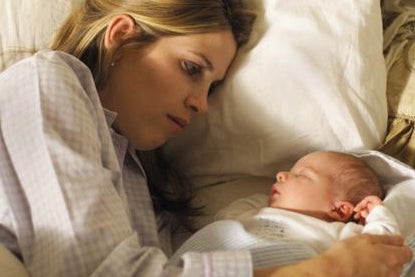
Photograph by Photodisc/Thinkstock.
The world has changed in the last months, even in the last week, the last days. My husband was listening last night to a podcast from two weeks ago—“It’s almost quaint,” he remarked. These changes extend to, and perhaps are even worse for, those who are pregnant. People who got pregnant nine months ago presumably did not imagine they’d be delivering amid a global pandemic. It’s scary; women are afraid for their own health and their babies. On top of this, the landscape of giving birth has been transformed, too.
Many hospitals across the country have begun to restrict who can be in attendance at births. For the most part, this has meant restrictions on doulas and outside visitors. But it has sometimes gotten more extreme. Last week, several hospitals in New York extended these restrictions to partners. For about a week, aside from the presence of doctors and nurses, some women who gave birth did so alone. Over the weekend, the State of New York issued an executive order cancelling this restriction; partners are now allowed during labor and delivery.
But even with the rollback of this extreme measure, the circumstances of hospital birth have clearly changed, in New York and elsewhere. Women who, say, envisioned giving birth with their partner and doula and mother alongside them find themselves in a very different situation. Moreover, hospitals in heavily affected areas have gotten scarier. Women worry about infection, either to themselves or their babies. Laboring women and their partners will often be asked to wear gloves and masks during delivery.
Perhaps not surprisingly, this has caused a lot of women close to delivery to re-evaluate their plans. I’ve been writing a lot about pregnancy, delivery, and children in the context of COVID-19 and among the most common questions I’ve gotten is: Hospitals seem scary, unwelcoming, and generally not what I imagined. Should I switch to a home birth?
To answer this, I think it’s useful to start with some basic facts about home birth in a non-COVID time period. First, we should note that for high risk women, this is not likely to be an option—this includes women whose babies are breech, or those with other pregnancy complications. And if you want an epidural or other pain relief, home birth is also not possible.
For low-risk women, there is some evidence that home birth is associated with an easier recovery. Comparing low-risk births that were planned to take place at home (regardless of where they actually took place) versus those that were planned to take place at the hospital, researchers found the planned home births had less monitoring, fewer epidurals, fewer episiotomies, less use of forceps, and a lower C-section rate. They also had fewer vaginal tears and lower infection rates.
However, there are also risks to home birth. First, a reasonable share of planned home births end up in a hospital transfer. This is perhaps 30 percent for first time births, 10 percent for later births. Second, at least some papers have argued that home births put babies at higher risk for bad outcomes, including infant mortality. I should emphasize that this is a controversial discussion. Individual research papers disagree and even review articles— which combine a lot of papers together to get a better picture—disagree.
In normal times, home births carries some risks, which are relatively small. But that’s in a non-pandemic world.
One very well-known article from ten years ago argues that infant mortality is 2 to 3 times as high for home births. A more recent one combines things differently and suggests there are no mortality differences. Likely part of the reason for the disagreement is that thankfully infant mortality is rare, which means that without a very large sample, all results are very noisy. Another key issue—relevant in the current moment—is that home births do seem to be safer with certified nurse midwife providers (sometimes called CNMs). Even the meta-analysis arguing that home birth is risky notes that this doesn’t extend to home births which are attended by CNMs.
Aggregating this, my read of the data is that in normal times, home birth carries some risks, but they are relatively small and may be outweighed by parents’ preferences, especially if you have a highly trained midwife and access to a hospital in an emergency.
But that’s all in the non-pandemic world. The question people are increasingly wondering about is switching to a home birth at the last minute in the middle of a pandemic. This adds a large number of risks. Finding a midwife at the last minute is likely to be difficult, meaning you are less likely to get someone with excellent training. You may not have prepared for the idea of an unmedicated birth. You need a lot of stuff, which you will now struggle to get.
Beyond this, the hospital transfer experience is likely to be much scarier. You may be worried about being at labor and delivery in general, but coming in as an emergency is likely to be even more fraught and scary. It may be hard to get an ambulance.
Another way to say this is that while the experience of birthing in a hospital has gotten worse, the relative safety of the two options during the pandemic more strongly favors a hospital birth. Not everyone will agree with this, of course, but this is how I read the data. If you have the option, laboring for longer before you leave for the hospital can help minimize time there. For some women, early discharge may be feasible, getting them out of the hospital faster, and home.
Readers like you make our work possible. Help us continue to provide the reporting, commentary and criticism you won’t find anywhere else.
Join Slate Plusfrom Slate Magazine https://ift.tt/2vYAsxp
via IFTTT
沒有留言:
張貼留言